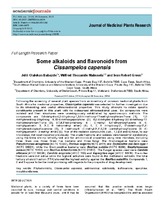| dc.description.abstract | Following the screening of several plant species from an inventory of common medicinal plants from South Africa for medicinal properties, Cissampelos capensis was selected for further investigation due to its interesting and useful ethnomedicinal properties. This study attempts to relate specific constituents present in this plant with its widespread ethnomedicinal uses. Six compounds were isolated and their structures were unambiguously established by spectroscopic methods. The compounds are: 5,6-dehydro-4,5-dihydroxy-1,3,6-trimethoxy-17-methylmorphinan-7-one (1); 1,2-methylenedioxy-3-hydroxy -9,10-dimethoxyaporphine (2); 5,6-didehydro-4-hydroxy-3,6-dimethoxy-17-methylmorphinan-7-one (3); 3,7,8,3'-tetramethoxy- 6 - C-methyl- 5,4'-dihydroxyflavone (6 -C-methylquercetin 3, 3',7, 8 -tetramethyl ether) (4); 5, 7, 8 -trihydroxy-2?, 5?-dimethoxy-3?,4?- methylenedioxyisoflavanone (5); 3 -methoxy-6 -C-methyl-3',4',5,7,8 -pentahydroxyflavone (6 -C- methylquercetin -3-methyl ether) (6). Five of the isolated compounds, (viz., 1,2,4,5 and 6) have, to our knowledge, not been reported previously. The crude fractions and isolates were tested for cytotoxicity using the brine shrimp lethality test and for antimicrobial properties using nine microbes, including three Gram -ve, three Gram +ve bacteria and three fungi. The Gram-negative bacteria were Pseudomonas aeruginosa (NCTC 10332), Proteus vulgaris (NCTC 4175) and Escherichia coli Sero type 1 (NCTC 09001), while the Gram-positive bacteria were Bacillus subtilis (NCTC 8236), Staphylococcus aureus (NCTC 13134) and Bacillus licheniformis (NCTC 01097). The Fungal species used were Candida albicans (ATCC 90028), Candida eropiralis (ATCC 750) and Aspergillus niger (ATCC 10578). The n-Hex fractions were not active while the highest activities were found in the methanolic extracts. The total tertiary alkaloid fraction (TTA) showed the highest activity against the Bacillus substillis. Compounds 1, 2 and 5 appear to be the most promising with regards to the prospects of drug development. | en_US |

